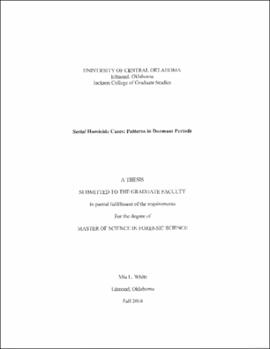| dc.contributor.advisor | Mabry, John | |
| dc.contributor.author | White, Mia L. | |
| dc.date.accessioned | 2020-07-09T14:39:07Z | |
| dc.date.available | 2020-07-09T14:39:07Z | |
| dc.date.issued | 2016 | |
| dc.identifier.other | (AlmaMMSId)9982529077302196 | |
| dc.identifier.uri | https://hdl.handle.net/11244/325011 | |
| dc.description.abstract | The study of serial homicide offenders has been extensively investigated, however, there is a significant gap in the literature with respect to the dormant period. Little information is available with regard to patterns, length, or specificity of dormant periods, specifically, pertaining to the offenders' individual/unique patterns. To investigate this topic, the length of the dormant period in serial homicide cases was assessed. In conjunction with the Radford University Serial Killer Information Center, the dormant period of 40 serial homicide offenders was evaluated. The study hypothesized that the duration of dormant periods in serial homicide cases could potentially demonstrate a quantifiable pattern to predict future offenses. Specifically, it was hypothesized that as the number of kills for a particular killer increased, the length of the killer's dormant period would decrease and level out to a predictable pattern. The ability to detect identifiable patterns in an offender's dormant period would allow law enforcement to assess a quantifiable dataset that could benefit them in ultimately apprehending the serial murderer. By establishing patterns in dormant periods for serial murderers, law enforcement could apply the same approach to other serial offenders such as serial arsonists, robbers, and rapists to determine the likelihood of if and when recidivism would occur. The results were not significant in supporting the hypothesis that as kills increase, the length of the dormant period would decrease (p=0.188). However, whether or not the offender was incarcerated during the period since the previous kill was found to be significant (p<0.001). Interestingly, when the data produced from one particular killer was excluded, the overall data showed significance (p<0.001). | |
| dc.rights | All rights reserved by the author, who has granted UCO Chambers Library the non-exclusive right to share this material in its online repositories. Contact UCO Chambers Library's Digital Initiatives Working Group at diwg@uco.edu for the permission policy on the use, reproduction or distribution of this material. | |
| dc.subject.lcsh | Serial murderers | |
| dc.subject.lcsh | Criminal behavior, Prediction of | |
| dc.subject.lcsh | Crime forecasting | |
| dc.subject.lcsh | Crime analysis | |
| dc.subject.lcsh | Homicide investigation | |
| dc.title | Serial homicide cases : patterns in dormant periods. | |
| dc.type | Academic theses | |
| dc.contributor.committeeMember | Lord, Wayne | |
| dc.contributor.committeeMember | McCoy, Mark R. | |
| dc.thesis.degree | M.S., Forensic Science | |
| dc.subject.keywords | Criminology | |
| dc.subject.keywords | Psychology | |
| dc.subject.keywords | Cooling-off period | |
| dc.subject.keywords | Dormant period | |
| dc.subject.keywords | Homicide | |
| dc.subject.keywords | Serial homicide | |
| dc.subject.keywords | Serial murder | |
| dc.identifier.oclc | (OCoLC)ocn982492821 | |
| uco.group | UCO - Graduate Works and Theses::UCO - Theses | |
| thesis.degree.grantor | Jackson College of Graduate Studies. | |
